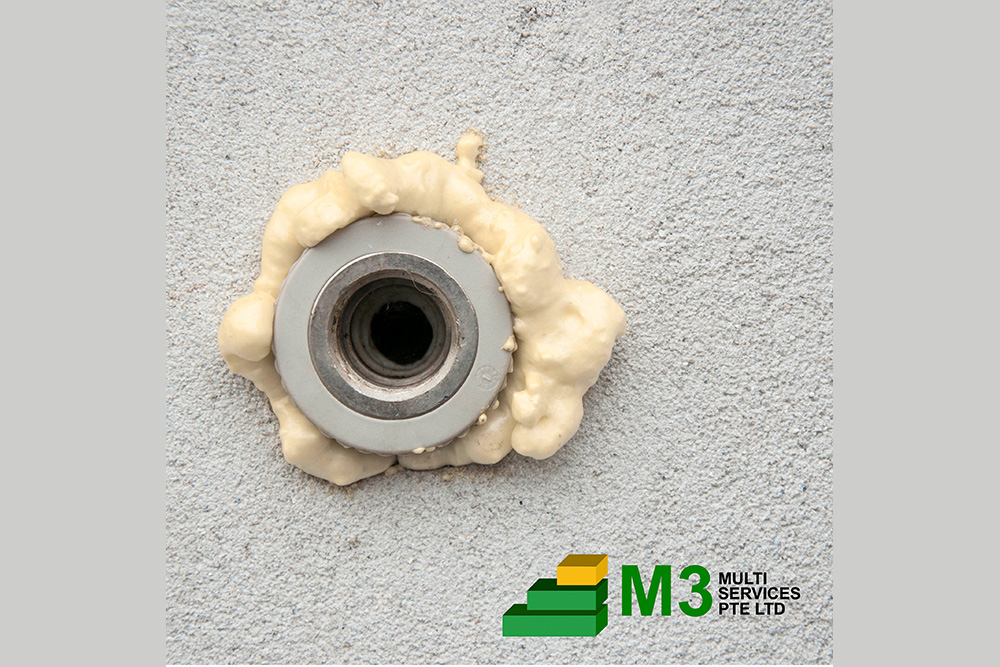Cracks are a common house problem. While it is not surprising to see them in your interior, this seemingly simple issue can cause a bigger one if not immediately addressed. The cracks give way for water to pass through inside your home. To resolve this, waterproofing solutions in Singapore like PU grouting have grown in popularity with house owners.
PU grouting, also known as polyurethane injection, is a waterproofing technique that injects polyurethane, a fluid resin, to prevent water leakage through cracks or gaps in the building structures’ concrete. The resin has low viscosity, allowing the material to expand and seal tiny cracks to avoid further leakage. After injection, it also retains its flexibility, allowing subsequent movement in the structure while keeping the gaps filled.
As a homeowner, you may be hesitant to try new ceiling waterproofing methods, thinking how it may affect your interior’s structure. However, not addressing the leakage problem does more damage to your damage than PU grouting in Singapore does.
How Does Water Leakage Affect Your Interior?
As we’ve established, simple cracks lead to a bigger problem once water seeps through them. Some of the ways that water leakage affects your interior structure include the following:
- Strange Odors
Water leakage often leaves a musty smell inside your home. The odour is strong and very noticeable. Once you smell a musty odour that hasn’t been there before, check the possible source of the smell. It may have been from an unattended leakage. Take this as an early sign that you need PU grouting.
- Discolouration
Another problem caused by water leakage is the discolouration of the walls or ceiling. If you notice an off-white or yellowish stain within your interior, it may mean that water has passed through cracks. Consider it a major warning sign of a possible problem.
- Sagging Walls or Ceiling
If left unaddressed, cracks lead to the accumulation of water in one spot of the home interior. Due to the heavy flow, you will start to notice sagging in the walls or ceiling. It may not be noticeable at first, but as time goes by, water volume becomes fuller, causing the interior to sag further. Once you notice a sudden bulge in the ceiling or walls, it may be a sign of water accumulation and waterproofing is needed as soon as possible.
Process of PU Grouting in Singapore
So, out of the ceiling waterproofing methods out there, what makes PU grouting a desirable choice for many homeowners? Aside from being a foolproof solution to water leakage, PU grouting in Singapore saves you time, money and effort, as it has a short curing time and very low cost.
To some extent, PU grouting is non-invasive to your home’s interior. It doesn’t involve hacking away your current flooring, walls, or ceiling, which will also require you to spend on new tiles, wallpaper, or paint. It’s also convenient as you don’t need to do a major clean up after it’s completed, nor does it produce much hacking noise.
To have a clearer idea, here is how PU grouting in Singapore is done:
- Cleaning
- The technician cleans the area and removes mineral deposits left from the water leakage. This way, they can analyze the site and determine the location of the crack.
- Drilling
- A hole is drilled to make way for the injection of the resin. The angle while drilling should be 45 degrees or less towards around 2/3 of the structure’s thickness. There’s also a 20 cm to 30 cm space between the holes.
- Insert Packers
- The technician will place a grouting nozzle injection packer in the drilled hole. A special hexagon wrench is tightened, leaving no gap between the nozzle and drilling hole for the water to leak into.
- Seam Cleaning
- The technician will inject clean water into the mechanical packers using a high-pressure cleaning machine. At the pressure of 6Mpa, the device will clean off the area from dust.
- Sealing Cracks
- The leaking cracks’ surface is sealed with a cement-based waterproof material during the washing stage so that the polyurethane will not seep out.
- Grouting
- The technician will then inject the polyurethane into the hole using a high-pressure injection grouting machine. They will elevate the grouting machine bottom-up and start injecting the resin one hole at a time.
- Removing the Packers
- After grouting, the grouting nozzle will be removed by the technician if there is no more leakage. They will then proceed to clean up the irrigation fluid that may have spilt and solidified.
- Sealing
- The technician will again seal the injected area of the concrete with cement-based waterproof material.
- Waterproofing
- The technician will smear the grouting area with a single component waterproof material to fully fortify the area, with a 10-20 cm width and 20-30 cm length at both ends.
PU grouting is a more technical and niche method of waterproofing in Singapore. Doing it by yourself may cause more damage to your interior. Luckily, some contractors specialize in the technique that can help you.
M3M: Professional Waterproofing Company
M3 Multiservices Pte Ltd is one of the leading waterproofing contractors in Singapore. For 9 years, the company has built a strong clientele through its excellent waterproofing services, using advanced and innovative technologies. M3M also offers an on-site analysis to figure out the solutions that will best suit the needs of your property.
M3M offers a full range of waterproofing procedures such as PU grouting for RC flat roofs, pitched roofs, fixed roof awnings, open balconies, wet areas (i.e. kitchens and bathrooms), as well as walls and basements.
Aside from waterproofing, the company also offers other services such as painting and coating, minor works in construction, and other general contract work, to ensure that ceiling leak will not be a problem for a long time. M3M is a reliable waterproofing company that delivers high-quality service every time.


